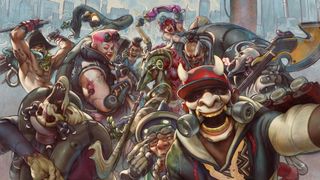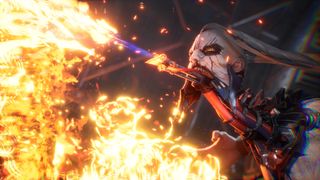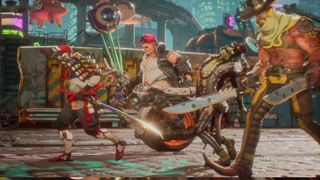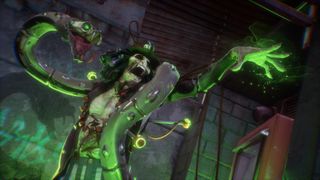
Unrealistic expectations are little more than premeditated resentments. As far as old adages go, this one feels particularly apt in the case of Bleeding Edge. Ninja Theory's upcoming team fighter found itself being compared unfavourably to Overwatch in the weeks before its official reveal, and has been written off as little more than a melee-based version of Blizzard's hero shooter in the months since.
When you come into any new creative endeavour with these kinds of expectations in mind, it's easy to resent it for not delivering on them. But here's the truth: that comparison does Bleeding Edge a massive disservice. You're doing yourself a disservice, too, because the underlying experience is a fun and competitive way to blow off a couple of hours. My advice is to go into Bleeding Edge with an open mind and give it a chance – be it in beta, at release, or via Xbox Game Pass. Hell, you might even enjoy yourself.
That isn't to say the game isn't without its problems, of course, but Bleeding Edge does enough right that it managed to drag me away from Modern Warfare season 2 and Apex Legends season 4 for an entire weekend – in a world where time is fast becoming my most valuable currency, the closed beta holding my attention for that long has to count for something. Perhaps it's because I found something attractive about the cut of Bleeding Edge's fast-paced arena action. Of the character and charisma flowing through its visual and audio design, and of the attention to detail that is apparent in everything it does, from each of the hero's distinct animation cycles to the surprisingly deep modification system.
There's also an easy, familiar rhythm to the pace of its action. I'm not going to sit here and tell you that the combat has the depth of DmC: Devil May Cry or Heavenly Sword, but Bleeding Edge does play to Ninja Theory's strengths as a studio known for creating melee-focused action experiences. Combos are delivered easily and can be devastatingly effective if used in tandem with support from your teammates. There's a parry system hidden in there for anybody that can resist the urge to constantly dart around in the fray of four-versus-four combat, bringing a sharp edge of skill to the game – particularly when paired correctly with the array of unique cooldown-bound abilities that each hero can unleash.


The head of Xbox Game Studios outlines Microsoft's commitment to first-party studios, a desire to "deliver a game every three to four months", and more in our exclusive interview with Matt Booty.
One of the biggest strengths of Bleeding Edge – and one of the toughest hurdles Ninja Theory will need to cross – is the focus on objective-centric game modes. Players are tasked with simultaneously completing shifting objectives on large, carefully constructed maps, all while attempting to tease individual enemies away from their pack and into devastating one-versus-many confrontations. In Bleeding Edge, groups that stay together, win together.
That's because there is rarely room for individual heroics in Bleeding Edge. The game is specifically tailored to group-play, and any team that can organise even a rudimentary composition between Tank, DPS, and Support characters stand a real shot at total domination against a fractured enemy squad. Ninja Theory has even taken notice of Apex Legends' lead here and introduced a Ping System, letting you communicate effortlessly without opening the Pandora's box of abuse that can come from activating your microphone on Xbox Live. As great as this system is, Ninja Theory still needs to better communicate that completing objectives and tussling over hotly-contested areas is the core of the game, rather than chasing an attractive K/D ratio. Bleeding Edge will live and die by the community that forms up around it, and objective-based, team-play needs to be at the heart of it all.
The reason for that is, when Bleeding Edge is played as it is designed to be, the game is fun and chaotic on its most fundamental level. I'm already starting to get a sense of the depth to each of the 11 characters, of how they can be manipulated smartly through the modification systems, and of their utility when paired up with other heroes. It's thrilling in a way that a third-person Overwatch never could be.
Sign up to the GamesRadar+ Newsletter
Weekly digests, tales from the communities you love, and more
In fact, if you're looking for a point-of-comparison, Bleeding Edge is arriving with some big Monday Night Combat vibes. There are echoes of Gotham City Imposters in there too, and you can just about feel the influence of Smite in some areas of its design if you squint hard enough. It feels like the sort of class-based arena combat game that would have found massive success on Xbox Live Arcade circa 2009-2012, pulling in elements of the burgeoning MOBA scene with third-person action games' propensity towards individual powers and strength in numbers.
The Ninja Theory touch

Ninja Theory is a studio praised for its single-player games – Heavenly Sword, Enslaved: Odyssey to the West, DmC: Devil May Cry, Hellblade: Senua's Sacrifice. That legacy has been used by some as a way of drawing a negative towards Bleeding Edge, because it's a multiplayer-only title. By wielding the studio's legacy in this way, the truth at the heart of the sentiment gets lost; Ninja Theory is a studio that knows how to build characters. And Bleeding Edge has some pretty awesome characters.
Look a little deeper at Bleeding Edge's edgy aesthetic, and you'll see Ninja Theory permeating its lore straight into the game proper in some delightfully playful ways. Check the Bleeding Edge website, and you'll learn that New Yorker native Daemon is a gifted graffiti artist, reflected in-game by each slash of his blade, which leaves smears of paint behind it, splashing colour across a canvas of chaos as you frantically attempt to take enemies down one by one. Every character bears their own set of idiosyncrasies in this way, all designed to subtly reveal more about their identity and backstory. From the playful idle animations of tech prodigy Zero Cool to Miko's ballet-like combat style, everything is designed to draw you further into the world and story of Ninja Theory's new universe.

"Bleeding Edge isn't the game any of us expected from Ninja Theory, but it's the one we are getting"
Bleeding Edge isn't the game any of us expected from Ninja Theory, but it's the one we are getting – and it's worth playing on its own merits before wishing it away entirely. There's a lot to love here and, judging by what I saw in the closed beta, a lot of depth too. By its final day, I was beginning to get a better sense of the different ways the modifications could change each hero and their utility in combat, not to mention just how much of an effect each configuration can have on team-composition and tactics.
Expectation for Bleeding Edge isn't just low, it's gone subterranean. It shouldn't be this way, but perhaps it was always to be expected – given the vitriol Ninja Theory has faced since its founding in 2003. From angering the Xbox crowd with its 2007 PS3 exclusive Heavenly Sword and riling up the PlayStation Nation by going multi-platform with 2010's Enslaved: Odyssey to the West, to becoming public enemy number one with DmC: Devil May Cry in 2013 for having the audacity to take Dante to a new stylist. There's a good chance Bleeding Edge will upset anybody expecting a third-person Overwatch too. But should you leave your expectations at the door, there's a very good chance it might just become your next big obsession for 2020.

Looking for an opportunity to try Bleeding Edge for yourself before it launches on Xbox One, PC, and in Xbox Game Pass on March 24, 2020? Check out the Bleeding Edge beta times for more information.

Josh West is the Editor-in-Chief of GamesRadar+. He has over 15 years experience in online and print journalism, and holds a BA (Hons) in Journalism and Feature Writing. Prior to starting his current position, Josh has served as GR+'s Features Editor and Deputy Editor of games™ magazine, and has freelanced for numerous publications including 3D Artist, Edge magazine, iCreate, Metal Hammer, Play, Retro Gamer, and SFX. Additionally, he has appeared on the BBC and ITV to provide expert comment, written for Scholastic books, edited a book for Hachette, and worked as the Assistant Producer of the Future Games Show. In his spare time, Josh likes to play bass guitar and video games. Years ago, he was in a few movies and TV shows that you've definitely seen but will never be able to spot him in.
Most Popular



